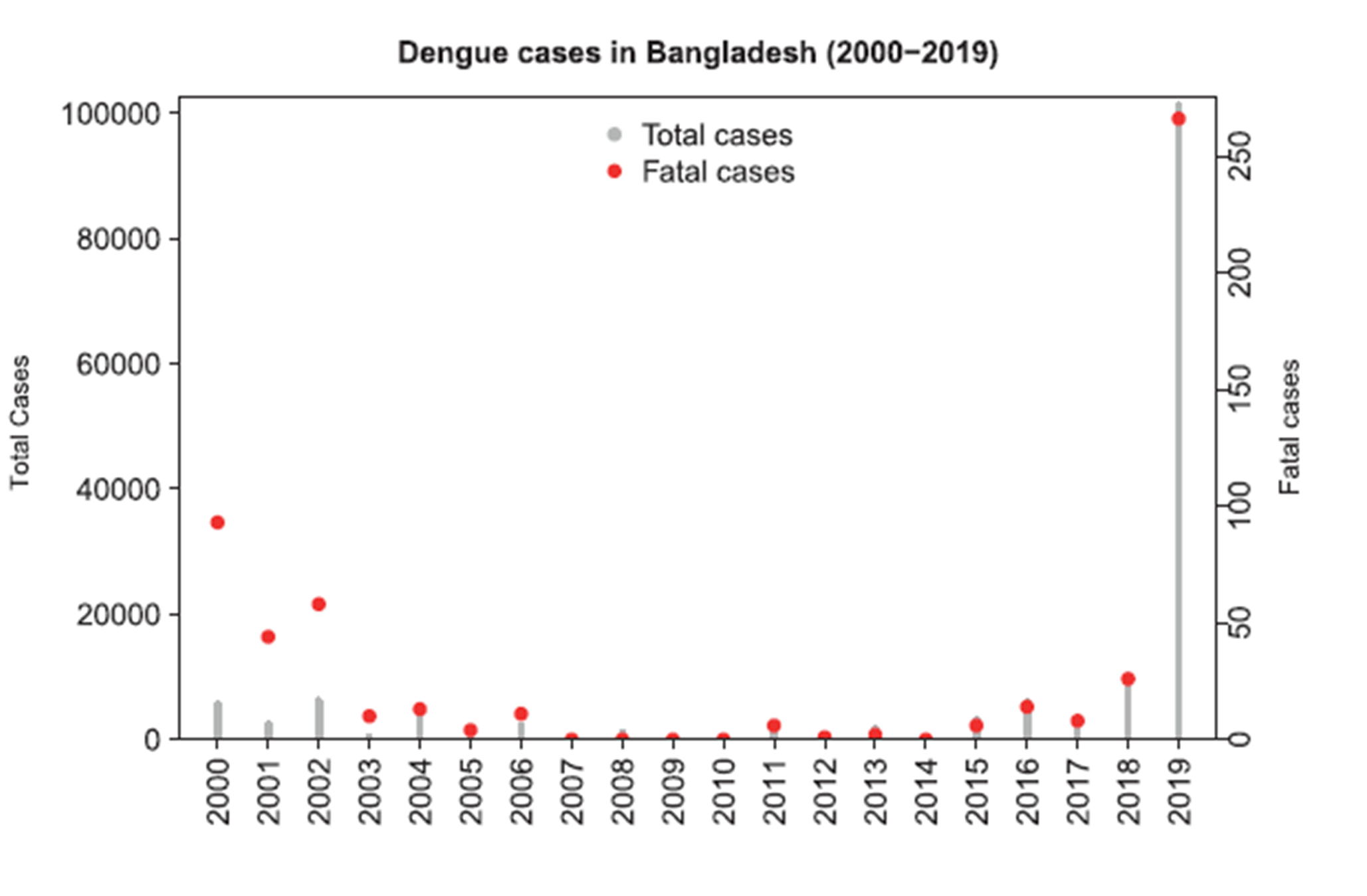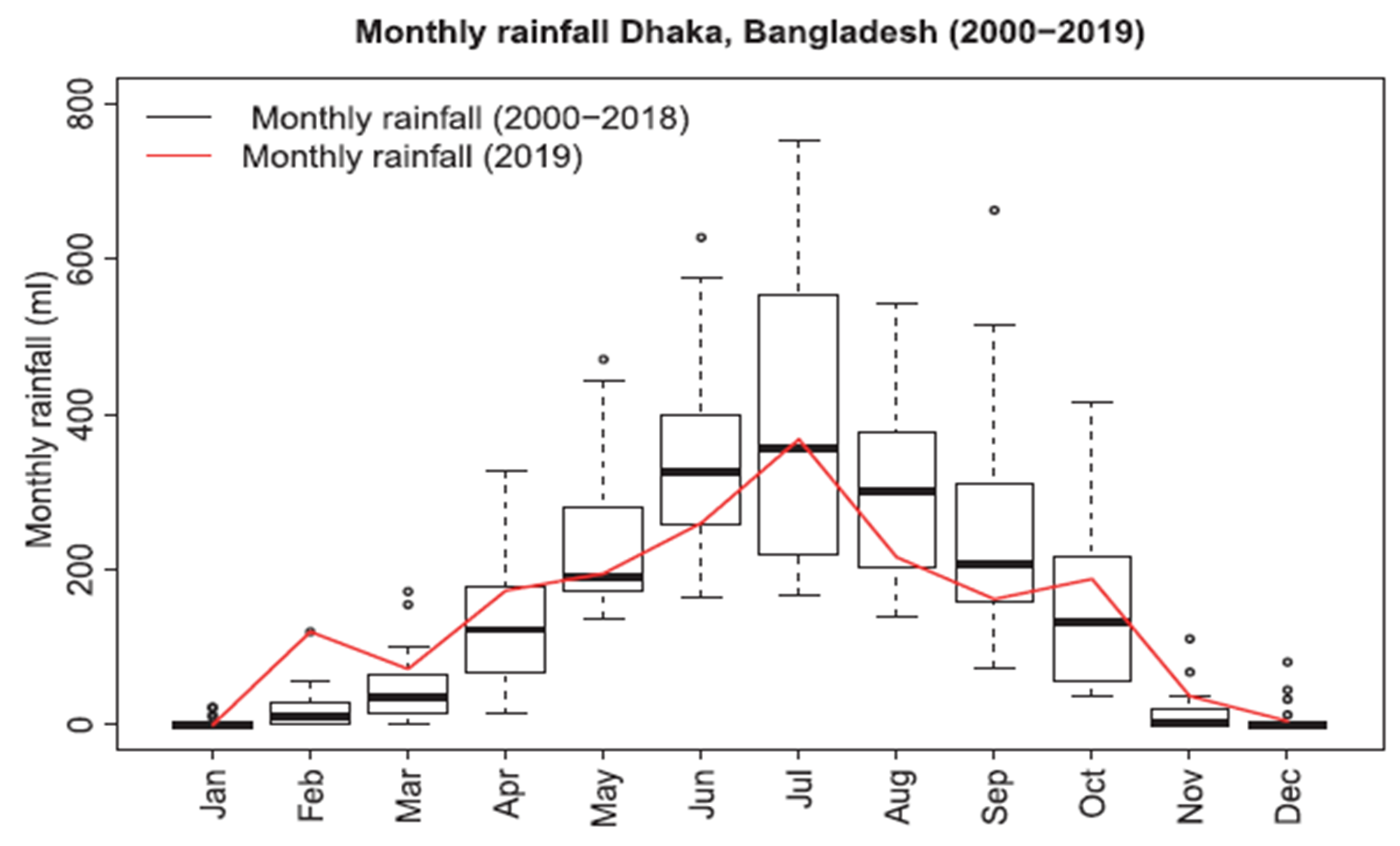Dengue fever is caused by four serotypically-distinct dengue viruses (DENV-1 to DENV-4) transmitted by Aedes spp mosquitoes. Infection with one of these serotypes does not protect against another, except in the first few (4-6) months after infection . Since 2000, Bangladesh has reported DENV cases every year until the 2019 surge. However, under-reporting is highly likely and previous reports include data from only a selected number of government hospitals and private clinics within the country (Directorate General of Health Services (DGHS) 2019, Mamun et al. 2019). The number of dengue patients reported by the Institutes of Epidemiology Disease Control and Research (IEDCR), a research wing of Ministry of Health and Family Welfare, represents the patients from in-patient departments of 12 government or autonomous hospitals and 29 among 609 private hospitals (Bangladesh Private Clinic Diagnostics Owners Association. Dengue cases were identified based on clinical symptoms of DENV including fever, rash, and/or laboratory test for dengue virus (Immunoglobulin(Ig) M or IgG , and Non-structural 1 Protein (NS1) of dengue virus (Diseases Control Division (DGHS) 2013). Nevertheless, data on dengue patients who did not develop symptoms or developed mild symptoms and did not seek medical attention were unknown and are not included in these records.
Dengue Cases in Bangladesh:
The number of total (gray symbol) and fatal (black symbol) dengue cases in Bangladesh between 2000 and 2019. Note the different scales on the two y-axes. The number of dengue cases detected in 2019 was more than double the cumulative number of cases detected in the previous 19 year.

How Climate Change effecting Dengue Cases
In Bangladesh, the dry season extends from Nov to Feb and rainfall is very rare in this period. However, during 2019 a record 120 ml rainfall was documented during February in Dhaka city by the Bangladesh Meteorological Department, the highest rainfall for 2000-2019 period (mean 15 ml (range: 0-56)) (Fig 2). After that initial heavy rainfall, intermittent rainfall continued until Oct 2019. Therefore, the vector season started earlier compared to previous years which may have helped Aedes mosquitoes maintain a steady population growth and continue the DENV epidemic until end of the year. We performed the Mann-Kendell trend analysis for annual mean rainfall data collected from Bangladesh Meteorological Department between 2000-2019 and observed a variation of rainfall without any trend (p=0.63, tau=0.12). Similarly, for the month of Feb alone (2000-2019), there was fluctuations of rainfall without any detectable trend (p=0.31, tau=0.17). Although in 2019, total annual rainfall was comparable to other years in the decade, the monsoon started much earlier (18 Feb 2019) and continued much longer than previous years. We performed the Spearman’s correlation coefficient test between annual rainfall and total number of dengue cases in Bangladesh, which resulted a poor correlation coefficient CC: 0.10). However, when we considered amount of rain during the early period of the year, i.e., sum of rainfall from January to April, the correlation coefficient increased to 0.39. Although only correlative, our findings suggest that early rain might be one factor along with others associated with other factors, which contribute to increased number of dengue cases in the country. Active surveillance to monitor mosquito population abundance is absent in Bangladesh. However, previous reports indicated that Aedes populations reach a peak in July and August (Ahmed et al. 2007). Therefore in 2019, the mosquitoes had 2-3 additional months to increase the population and contribute to the large epidemic. A similar trend of monsoon rain and increased dengue incidence previously was observed in Southern China (Liu et al. 2020)

Ahmed, T. U., G. M. Saifur Rahman, K. Bashar, M. Shamsuzzaman, S. Samajpati, S. Sultana, M. I. Hossain, N. N. Banu, and A. M. S. Rahman. 2007. SEASONAL PREVALENCE OF DENGUE VECTOR MOSQUITOES IN DHAKA CITY, BANGLADESH. Bangladesh J. Zool. 35: 205–212.
Aïzoun, N., R. Ossè, R. Azondekon, R. Alia, O. Oussou, V. Gnanguenon, R. Aikpon, G. G. Padonou, and M. Akogbéto. 2013. Comparison of the standard WHO susceptibility tests and the CDC bottle bioassay for the determination of insecticide susceptibility in malaria vectors and their correlation with biochemical and molecular biology assays in Benin, West Africa. Parasit. Vectors. 6: 147.
Alam, M. S., H. M. Al-Amin, and F. T. Johora. 2018. Baseline survey of insecticide resistance in Aedes aegypti in Bangladesh, Manuscr. Prep. Dhaka.
Collins, E., N. M. Vaselli, M. Sylla, A. H. Beavogui, J. Orsborne, G. Lawrence, R. E. Wiegand, S. R. Irish, T. Walker, and L. A. Messenger. 2019. The relationship between insecticide resistance, mosquito age and malaria prevalence in Anopheles gambiae s.l. from Guinea. Sci. Rep. 9: 8846.
This website was produced with the support of the United States Agency for International Development (USAID) under the terms of USAID's Research for Decision Makers (RDM) Activity cooperative agreement no. AID-388-A-17-00006
Views expressed herein do not necessarily reflect the views of the U.S. Government or USAID. icddr,b is also grateful to the Governments of Bangladesh, Canada, Sweden and the UK for providing unrestricted/institutional support
68, Shaheed Tajuddin Ahmed Sarani Mohakhali, Dhaka 1212, Bangladesh
icddr,b is located at the Mohakhali area in Dhaka, just ask your driver for the "Cholera Hospital"
